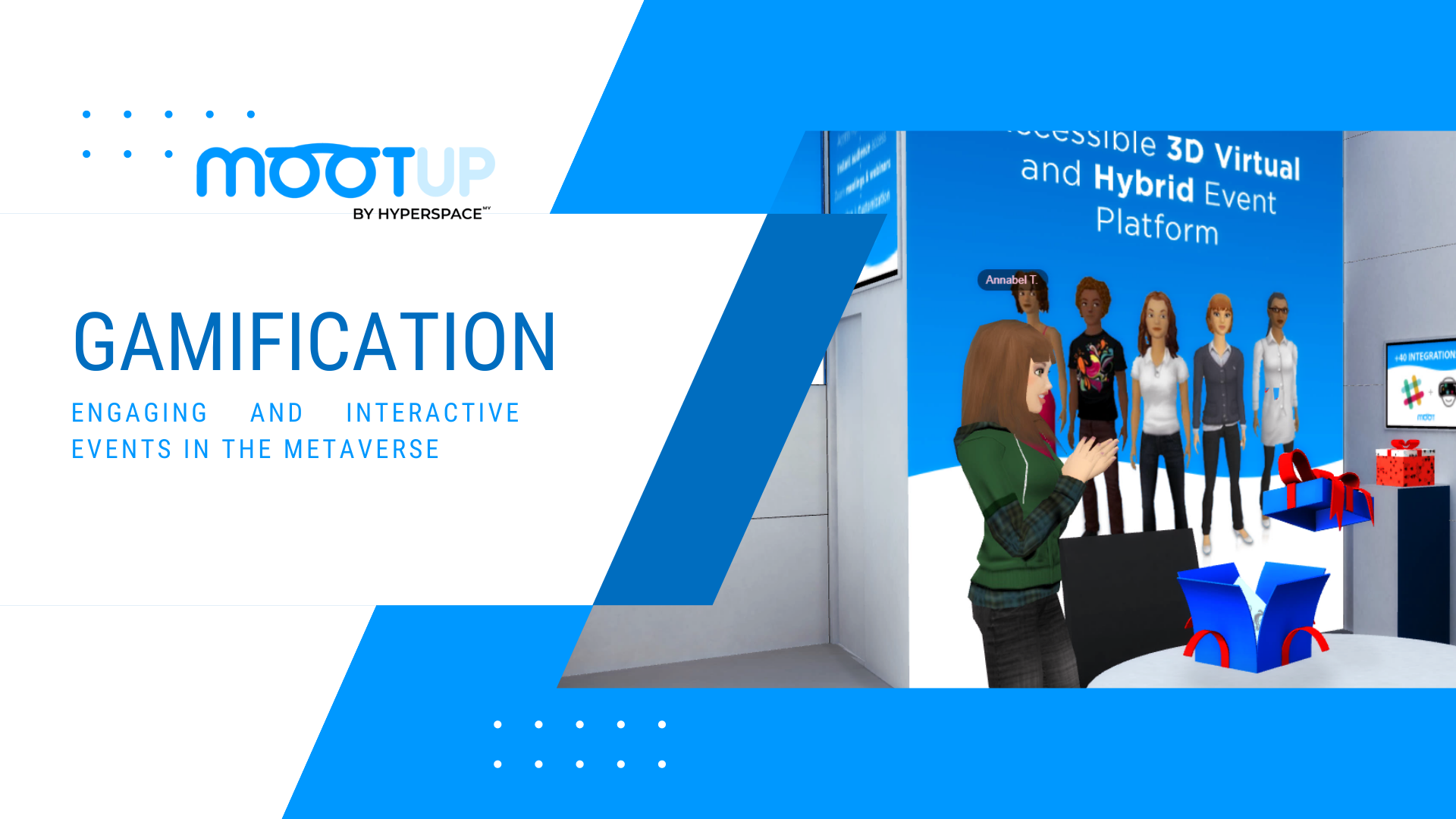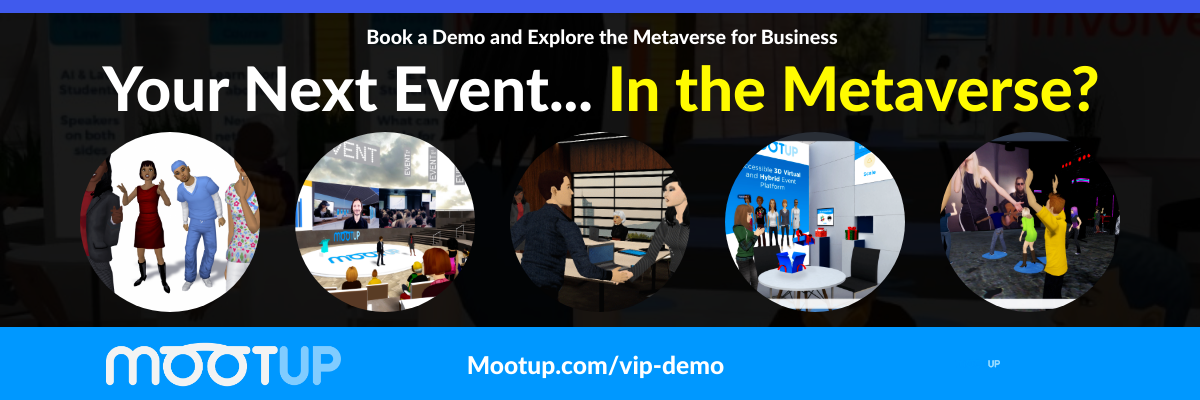As the world of events continues to evolve, virtual event design has become crucial in creating engaging and memorable experiences for attendees. With countless platforms and technologies available, event industry professionals must stay ahead of the curve when designing successful virtual events.
This blog post will explore various elements contributing to an exceptional virtual event experience. We’ll delve into the importance of selecting the right platform and customizing registration forms for tailored attendee experiences while incorporating physical swag to enhance engagement levels. Furthermore, we will discuss consistent branding through impactful conference graphics and how cohesive design elements reinforce brand identity.
Additionally, you can expect insights on interactive elements such as gamification strategies that foster collaboration and competition among participants. Lastly, we will highlight human-centered design solutions provided by industry professionals like Frog, which are pivotal in ensuring success in virtual event designs.
Table of Contents:
- Virtual Event Platforms and Customization
- Importance of Selecting the Right Virtual Event Platform
- Customizing Registration Forms for Tailored Experiences
- Utilizing Physical Swag to Enhance Engagement
- Consistent Branding in Virtual Conference Graphics
- Interactive Elements and Gamification Strategies
- Human-Centered Design Solutions by Industry Professionals
- Frequently Asked Questions Virtual Event Design
- Conclusion
Virtual Event Platforms and Customization
Choosing an appropriate virtual event platform with built-in segmenting features is crucial for successful virtual conference design. Tailoring the registration process to each attendee’s needs and preferences creates personalized experiences that resonate with your target audience. Sending physical swag before the event helps build anticipation and fosters a sense of connection among participants.
Importance of Selecting the Right Virtual Event Platform
Selecting a suitable virtual event platform is essential in ensuring seamless execution, user-friendly interfaces, and customizable options that cater to various industries requirements. A robust platform like MootUp, designed specifically for hosting virtual events in the Metaverse, offers no-code solutions that enable even non-technical users to produce engaging online gatherings without any hassle.
Customizing Registration Forms for Tailored Experiences
To create truly immersive experiences, it’s important to customize registration forms according to attendees’ needs and preferences. This can include asking questions about their interests or job roles during sign-up so you can provide relevant content during sessions. Doing this ensures every participant feels valued while attending your virtual conference or meeting.
- Add custom fields: Collect information specific to your industry or niche by adding tailored questions on the registration form.
- Create segmented lists: Based on collected data from registrants, group them into segments based on shared interests or demographics.
- Email personalization: Send targeted emails addressing individual concerns using dynamic content based on segmentation results.
Utilizing Physical Swag to Enhance Engagement
While virtual events have advantages, they can sometimes lack the tangible excitement of physical gatherings. To bridge this gap and create a sense of connection among attendees, consider sending out physical swag before the event. Send physical items such as t-shirts, mugs, brochures or event schedules to attendees before the virtual event to bridge the gap between physical and virtual gatherings.
Incorporating these elements into your virtual conference design will help ensure participants feel engaged and connected throughout the online experience. By selecting an appropriate platform like MootUp, customizing registration forms for tailored experiences, and utilizing physical swag to enhance engagement levels among attendees, you’ll be well on your way to hosting successful virtual events in today’s digital landscape.
Selecting the right virtual event platform and customizing registration forms are essential for creating a tailored experience that will engage your audience. Incorporating consistent branding into conference graphics can reinforce your brand identity while enhancing engagement.
Key Takeaway:
A no-code platform is being developed to create and host virtual and hybrid events in the Metaverse. This project focuses on designing engaging virtual events that will keep attendees interested throughout the event.
Consistent Branding in Virtual Conference Graphics
Maintaining consistent branding across all components of a virtual conference, from colors to graphics to overall design aesthetics, is vital in conveying a clear message to attendees. Every element should work cohesively throughout the online experience, reinforcing your brand identity while keeping attendees engaged during events.
Key Aspects of Effective Virtual Conference Graphics
To create an impactful and memorable virtual event design, consider these key aspects:
- Color Scheme: Choose colors that represent your brand and resonate with your target audience. Consistency in color usage helps establish familiarity and reinforces brand recognition.
- Typography: Select fonts that easily read on various devices and screen sizes. Stick with one or two complementary typefaces for consistency throughout the event materials.
- Imagery: Use high-quality images relevant to your event theme or industry. Incorporate branded visuals such as logos or icons consistently across presentations, banners, and other promotional materials.
- Navigational Elements: Create user-friendly navigation menus that allow attendees to access different sections of the virtual conference platform without getting lost or overwhelmed.
Reinforcing Brand Identity through Cohesive Design Elements
A well-designed virtual event set can significantly enhance attendee engagement by creating immersive experiences reflective of your organization’s values and mission statement. To ensure seamless integration between various elements within a digital environment like MootUp no-code platform designed specifically for hosting hybrid events, consider working closely with a skilled virtual event designer.
Incorporating cohesive design elements elevates the overall aesthetics of your virtual conference and helps attendees feel more connected to your brand. For example, consider using branded backgrounds for speaker presentations or designing custom avatars that align with your organization’s visual identity.

Consistent branding in virtual conference graphics is crucial in creating an engaging and memorable experience for event industry professionals attending online gatherings. You can ensure a successful and impactful virtual event by focusing on key aspects such as color schemes, typography, imagery, and navigational elements while reinforcing brand identity through cohesive design components.
Consistent branding for virtual event design across all virtual conference graphics ensures the event’s message resonates with attendees. Moving forward, we’ll explore how interactive elements and gamification strategies can engage audiences through collaboration and competition.
Key Takeaway:
This project aims to create a no-code platform to produce and host virtual and hybrid events in the Metaverse. This topic focuses on designing virtual events, which involve creating engaging experiences for attendees using various tools and techniques.
Interactive Elements and Gamification Strategies
Incorporating interactive elements such as collaborative games or awarding points for session attendance keeps participants engaged during events. Innovative examples within virtual conferences include Travis Scott’s unique musical journey and NBA’s “Together Mode”. Creativity knows no bounds when designing memorable online gatherings using gamification strategies.
Engaging Audiences through Collaboration and Competition
Consider incorporating various forms of collaboration and competition into the experience to keep attendees interested in your virtual event. This can be achieved by implementing live polls, quizzes, chat rooms, or breakout sessions, encouraging participant interaction. For example, you could create a scavenger hunt where attendees search for hidden clues throughout the virtual conference space or have them compete in team-based challenges related to your industry.
Tips for Successful Collaborative Activities:
- Create clear instructions and objectives for each activity
- Design activities that cater to different learning styles (visual, auditory, kinesthetic)
- Promote friendly competition by offering prizes or incentives for participation
- Schedule breaks between activities to prevent attendee fatigue
Examples Showcasing Innovative Approaches in Interactivity
The possibilities are endless when it comes to integrating innovative approaches into your virtual event design solutions. Some notable examples include:
- AstroWorld: Travis Scott’s Fortnite Concert: This groundbreaking event featured a virtual performance by rapper Travis Scott within the popular video game Fortnite. The concert attracted over 12 million viewers and set a new standard for immersive, interactive experiences in virtual events.
- NBA Together Mode: In response to the COVID-19 pandemic, the NBA partnered with Microsoft Teams to create an innovative fan experience called “Together Mode.” This feature allowed fans to virtually attend games through live video feeds displayed on massive screens surrounding the court. Fans could interact with each other during games while also being visible to players and TV audiences.
- Pokemon GO Fest: Niantic, Inc., creator of the hit mobile game Pokemon GO, hosted its annual festival as a global virtual event in 2023. Participants worldwide could join online for various challenges and activities designed specifically for this unique gaming community.
Incorporating interactive elements into your virtual conference design keeps attendees engaged and sets your event apart from others in today’s increasingly digital landscape. By exploring creative gamification strategies and learning from successful examples like those mentioned above, you can elevate your next event type virtual gathering into an unforgettable experience.
.png)
Interactive elements and gamification strategies are essential to engaging audiences during physical events and virtual events. With the help of industry professionals, human-centered design solutions can be implemented to create successful online experiences.

Efforts will be made to inform attendees about the event details, such as schedule and updates. Strategies will also be implemented to encourage attendees to participate actively and engage during the event. Depending on the event type and requirements, live streams may be utilized as a part of the event. Additionally, physical events may be organized, considering the unique aspects and considerations of in-person experiences.
The online events will begin with a virtual event design, and an event hashtag will be created to promote it on social media. It is a multi-day conference that aims to engage attendees throughout the duration. The event will occur in a physical venue, providing participants with a unique and immersive experience. Efforts will be made to engage attendees and create a memorable event in the physical venue.
With MootUp, you can create and launch your own Metaverse that is fully customizable to your brand and offers seamless transitions between immersive experiences, providing an always-on virtual world for your visitors.
Key Takeaway:
A no-code platform is being developed to create and host virtual and hybrid events in the Metaverse. The topic at hand is the design of these events, which involves planning and executing various aspects such as visual elements, interactive features, and engagement strategies.
Human-Centered Design Solutions by Industry Professionals
In virtual event design, industry professionals are crucial in creating engaging and immersive experiences for attendees. One such company is FrogFrog, which has helped organizations transition from traditional live events planning into digital spaces. They achieve this by leveraging remote technology solutions along with customer experience capabilities focused on human-centered designs— an approach proven effective when media companies sought assistance crafting integrated digital products compatible with popular video streaming services.
Role of Industry Professionals like Frog in Creating Engaging Online Experiences
Frog’s expertise lies in understanding the needs and preferences of users, enabling them to create tailored virtual event design solutions that resonate with attendees. By collaborating closely with clients, Frog ensures that their virtual conference graphics are consistent across all components while incorporating interactive elements and gamification strategies to keep participants engaged throughout the event.
- User research: Conducting extensive user research helps identify pain points and opportunities for improvement within existing platforms or processes.
- Design thinking: Applying a design thinking mindset allows professionals to develop innovative ideas based on insights gathered during user research.
- Rapid prototyping: Testing concepts through rapid prototyping enables quick iteration cycles before finalizing any solution or product launch.
The Importance of Human-Centered Designs in Successful Virtual Event Set-Ups
A successful virtual event set-up relies heavily on designing an environment that caters specifically to its audience’s needs. This can be achieved through human-centered designs, which prioritize empathy towards users while considering factors such as accessibility, inclusivity, engagement levels, and ease-of-use features,
- Accessibility: Ensuring that virtual event platforms are accessible to users with varying abilities and technical proficiencies is crucial for an inclusive experience.
- Inclusivity: Designing events with diverse perspectives promotes attendees’ sense of belonging, fostering stronger community connections.
- User engagement: Incorporating interactive elements such as polls, Q&A sessions, or collaborative games help maintain user interest throughout the event.
The virtual event design was meticulously planned, leveraging technology and platforms to create a successful virtual event that engaged attendees and provided a memorable experience. The event planning process included a comprehensive virtual event planning checklist, and virtual event branding was strategically incorporated to create a cohesive event strategy.
The virtual conference, with live streams and on-demand sessions, reached a wider audience. At the same time, in-person events were carefully planned to provide engaging in-person experiences with face-to-face interactions. Attendees were informed in real-time, with live polling and targeted audience engagement strategies, to encourage attendee participation and ensure a successful event.
The role of industry professionals like Frog in creating engaging online experiences cannot be overstated. By adopting human-centered design solutions and working closely with clients to understand their unique needs, these experts can craft memorable virtual events that leave lasting impressions on attendees.
Key Takeaway:
A no-code platform is being developed to create and host virtual and hybrid events in the Metaverse. This topic focuses on designing virtual events, which involve creating engaging experiences for attendees using various digital tools and technologies.
Frequently Asked Questions Virtual Event Design
What type of virtual event are you looking to create?
To determine the type of virtual event, consider your goals and audience. Common types include webinars, conferences, expos, product launches, training sessions, or networking events. Each requires different features and engagement strategies for a successful experience.
How will the virtual event be structured and organized?
A well-structured virtual event should have a clear agenda with defined session formats such as keynotes, panel discussions or workshops. Use tools like Sched for scheduling and organization. Include breaks for attendees to network or explore interactive elements like exhibitor booths.
What tools do you need to design a successful virtual event?
Selecting an appropriate virtual event platform, designing engaging graphics consistent with your brand identity, incorporating interactive elements like polls or Q&A sessions using tools like Slido, and providing opportunities for networking through chat rooms or breakout sessions are essential in creating a successful online experience.
How can you engage attendees in your virtual event?
Increase attendee engagement by incorporating gamification strategies (e.g., leaderboards), offering virtual conferences, live chats during presentations using platforms like Zoom, hosting roundtable discussions on specific topics via video calls, and allowing participants to submit questions before the session starts so speakers can address them directly during their talk.
What strategies should be used for promoting your virtual event?
Promote your in-person events virtual events through email marketing campaigns targeting potential attendees from existing databases; use social media channels effectively by sharing teasers about speakers/content, creating event-specific hashtags, and leveraging influencers; collaborate with event strategy partners to cross-promote the event; consider paid advertising on platforms like LinkedIn or Google Ads.
The target audience for the event is carefully considered, with strategies in place to engage and inform attendees in real time. Attendees were encouraged to participate through face-to-face interactions, live streams, and live polling. On-demand sessions were available to enhance the attendee experience, reaching a wider audience and ensuring attendees were well-informed throughout the event.
The event schedule is carefully planned, with a live event that was well-received by attendees. The event hashtag was promoted to create buzz on social media, and the target audience was identified and engaged in real time. Attendees were kept informed throughout the event, and efforts were made to encourage their participation. The event occurred in a physical venue, providing in-person experiences for attendees. Online events and multi-day conferences were also considered, focusing on engaging attendees in real time and providing up-to-date information.
Conclusion
Creating a successful virtual event design requires effort and dedication. Virtual event designers must know the challenges associated with this type of work, such as creating an engaging atmosphere that appeals to real time attendees. One can make their virtual event unforgettable by employing tried-and-true methods and considering useful advice. With the right approach and understanding of what goes into designing effective virtual events, any designer can make their mark in the world of digital experiences.
Elevate your Metaverse to be “futureproof” with MootUp – a browser-based platform that allows access from smartphones, tablets, laptops, and VR/AR headsets without downloading or software installation, ensuring seamless access across the devices.
Try MootUp to design and host virtual or hybrid events in the Metaverse. Our platform offers a streamlined experience for event organizers, with all the features you need to create an engaging and successful event.

